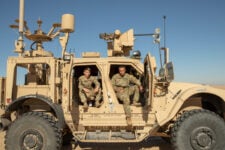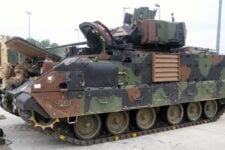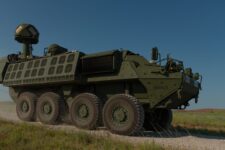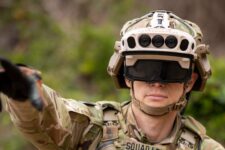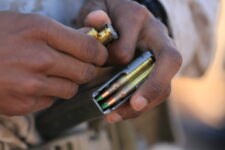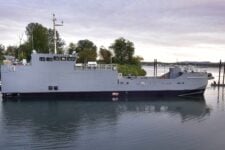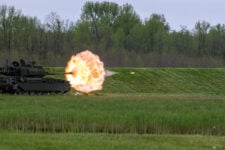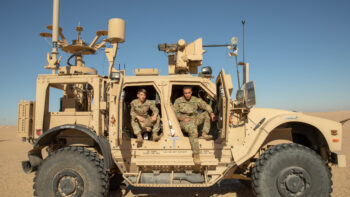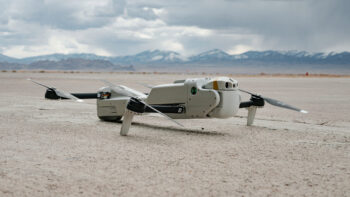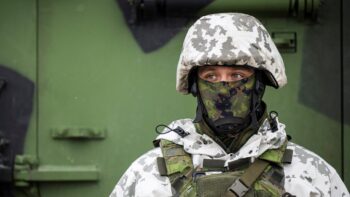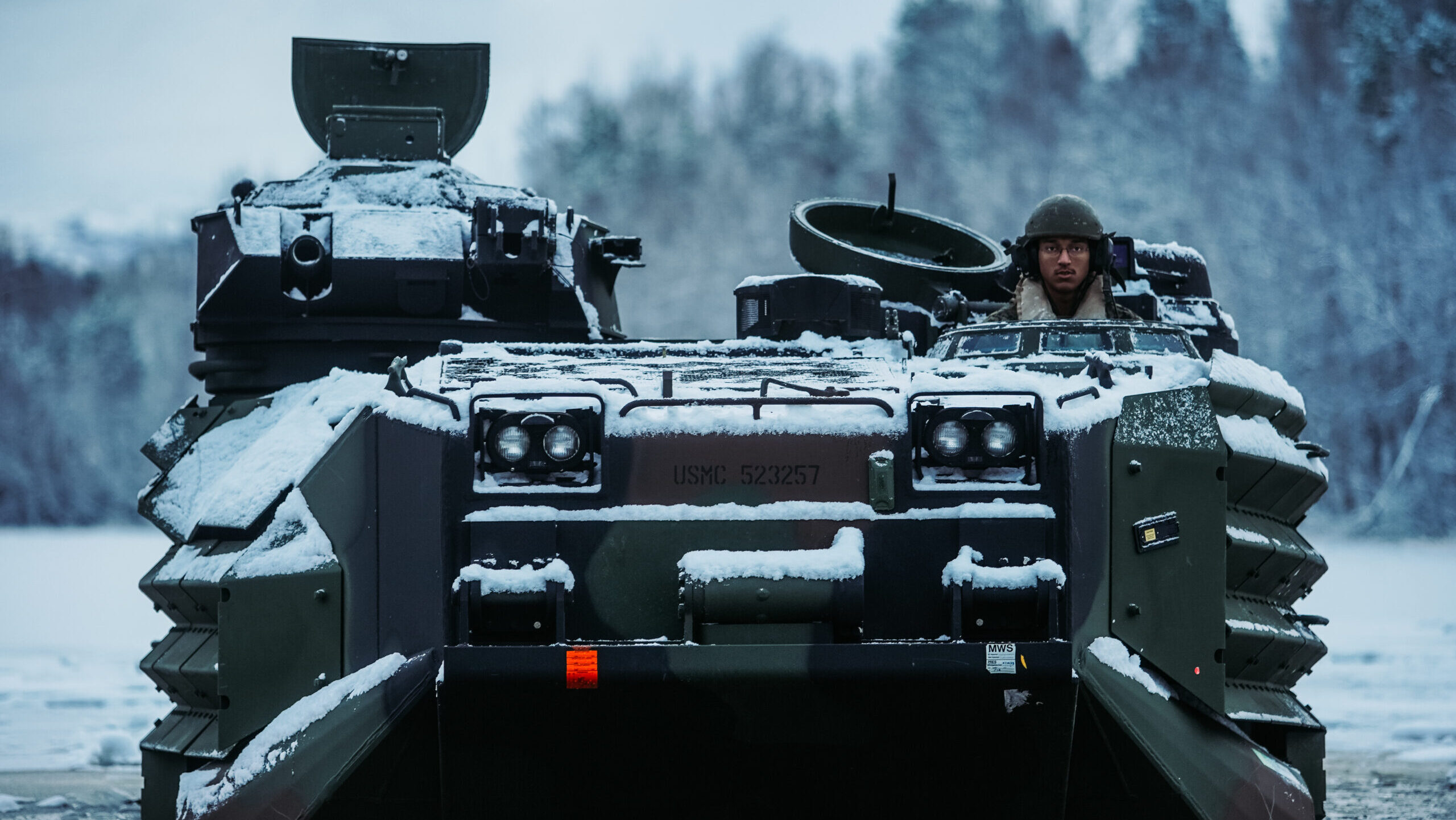
U.S. Marines with Marine Rotational Force-Europe 21.1, Marine Forces Europe and Africa, conduct a safety of use memorandum (SOUM) on an assault amphibious vehicle in preparation for Exercise Reindeer II, Reindeer I, and Joint Viking in Setermoen, Norway, Nov. 19, 2020. (U.S. Marine Corps photo by Cpl. William Chockey)
MODERN DAY MARINE 2024 — As the Marine Corps prepares for conflict in the West Pacific, its acquisition officials are begging industry for a new generation of technology, one better-suited to small units dispersed across austere islands far from friendly support.
Everything from sensors to computers to communications must be lighter, more compact, less power-hungry, and less prone to reveal locations to enemy sensors by emitting excessive heat or radio waves, three Marine Corps program managers told contractors at the Modern Day Marine conference this morning. Ease of deployment and sustainment are a must.
“No matter what theater we talk about — PACOM, Europe — everything needs to be smaller, lighter, so that we can deploy it,” said Col. Devin Licklider, program manager for MAGTF Command & Control at Marine Corps Systems Command. “[We want tech] that has less power consumption, makes less heat — and it’s very modular, so we can use it across [different] systems, or we can throw it in the back of a pickup truck, or we can throw it in wherever, [even if] it’s not fully integrated.”
That means the tech has to be highly sophisticated without being overly complicated to operate in rugged conditions and on mobile operations. Small units will need to relocate quickly to respond to crises and, once the shooting starts, to avoid enemy strikes. “The systems have to be extremely easy to set up, tear down, configure, [and] move quickly,” Licklider said.
The new tech also can’t depend on extensive support systems or contractor field service reps, which won’t be available to far-flung expeditionary forces. If two rival bidders both meet a program’s technical requirements, “we’re going to favor the one with the better sustainment solution,” said another MARCORSYSCOMS program manager, Richard Sessions, the civilian who handles tactical communications and electronic warfare systems. “We’re even willing to pay for it, prioritizing that [i.e. sustainability] over cost.”
Nor can contractors slim down frontline systems by simply offloading functions to the cloud. That’s an increasingly common expedient in the civilian world, where smartphones, tablets, and laptops have limited computing power and memory onboard but connect to distant server farms running everything from YouTube to Google Cloud to ChatGPT. Frontline forces can’t count on wifi and web access, however, especially once a sophisticated adversary starts jamming transmissions, hacking networks, and striking communications nodes. That means they need at least their most crucial capabilities to run on hardware they can carry — and keep maintained and powered — at the “tactical edge.”
RELATED: Empowered edge versus the centralization trap: Who will wield AI better, the US or China?
“We’re not going to always have 5G,” said Col. Thomas Dono, program manager for intelligence and cyber operations. “I know the Marine Corps is a little bit behind the industry standard in terms of moving to cloud, but there are concerns with the disconnectedness of the operating environment…so we’re trying to figure out what that mix is between tactical compute and cloud.”
It’s “critical” to get the right balance of “cloud versus edge” computing, agreed Linklider. When forward-deployed units can get a connection, the Marines absolutely want their junior leaders on the frontline to be able to access the full capabilities of the cloud.
“We don’t want to throttle that…We want to be able to take all the information that we have,” he said. “But then when things go bad, and either the adversary is shutting down our ability to get information, or we know we’re being observed and we don’t want to have a signature [e.g. radio transmissions], then how much edge compute do we need?”
That’s still very much an open question the Marines are still wrestling with in field experiments, Linklider said: “Won’t have those concepts of operations…for how we’re going to fight those nodes.”
Less Power And Weight For Greater Utility
Whatever the Marines decide in terms of tactics, however, the technical solution isn’t simply cramming as much computing power as possible into “edge” devices that fit into a Humvee or a backpack. It’s also stripping down software so it needs less processing power and memory to run.
“If we are only able to field [something like] a Dick Tracy wrist watch, that’s not going to have the full capability of the cloud with multiple servers … so that software has to be light enough and small enough,” said Dono.
One crucial technique the Marines want to use to slim down software is something called containerization, all three officials emphasized.
Already widely used in the commercial world, containerization essentially creates a self-sufficient software package that contains only the essential code and files that a particular program needs to run, eliminating aspects of the operating system unnecessary for that particular application. While less flexible than a full-up computer or virtual machine, a container is much smaller and easier to run.
Containerization, in turn, is just one aspect of a much wider push for what’s called modularity. Traditional defense programs built standalone systems, tightly integrating multiple functions into a single package using a single contractor’s proprietary technology. In more recent years, however, the military has been moving towards modular open systems architecture, a plug-and-play approach where they can pick the best product for a given function from any vendor, then fit different companies’ products together like Lego (hence “modular”) and have them all work together (the “open” part).
For example, said Sessions, the Marines would like various sizes of a “standardized chassis” into which frontline operators could plug-and-play different electronics cards for different functions — communications, navigation, electronic warfare, and so on — as needed. The smallest and most portable version might only accommodate two cards, he suggested, while heavier models might take six or seven, but any card would work in any size of chassis.
Modularity, in turn, requires different vendors to build compatible products, which means encouraging or imposing common technical standards. For Marine ground forces, the most important standard is the Army-led CMOSS. “I won’t say that we will completely ignore a solution or a capability that isn’t CMOSS-compliant,” Sessions said. “But… there’s definitely an advantage to going CMOSS.”
On many other complex questions, however, the Marine officials were quick to emphasize they haven’t locked in on one approach and are eager for input and innovation from industry. “We don’t have all those answers,” Dono said, “and so I think that’s opportunities for industry, with the folks in this room today, to help us understand what that looks like — what’s appropriate at the tactical level, and then what needs to be resident in the cloud.”
